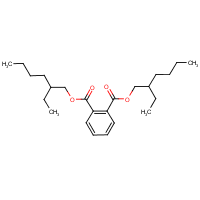Di-sec-octyl phthalate
Agent Name
Di-sec-octyl phthalate
Alternative Name
DEHP
CAS Number
117-81-7
Formula
C24-H38-O4
Major Category
Plastics & Rubber

Synonyms
DEHP; Diethylhexyl phthalate; Di(2-ethylhexyl)phthalate; Bis(2-ethylhexyl) 1,2-benzenedicarboxylate; Bis(2-ethylhexyl) phthalate; Bis-(2-ethylhexyl)ester kyseliny ftalove [Czech]; Bisoflex 81; Bisoflex DOP; Celluflex DOP; Compound 889; DEHP; DOF [Russian plasticizer]; Di(2-ethylhexyl) orthophthalate; Di(2-ethylhexyl) phthalate; Di(2-ethylhexyl)orthophthalate; Di(2-ethylhexyl)phthalate; Diacizer DOP; Diethylhexyl phthalate; Dioctyl phthalate; Ergoplast FDO; Ergoplast FDO-S; Etalon; Etalon (plasticizer); Ethylhexyl phthalate; Eviplast 80; Eviplast 81; Fleximel; Flexol DOP; Flexol Plasticizer DOP; Good-rite GP 264; Hatcol DOP; Hercoflex 260; Jayflex DOP; Kodaflex DEHP; Kodaflex DOP; Mollan O; Monocizer DOP; Nuoplaz DOP; Octoil; PX-138; Palatinol AH; Pittsburgh PX-138; Plasthall DOP; Platinol AH; Platinol DOP; RC Plasticizer DOP; Reomol D 79P; Reomol DOP; Sansocizer DOP; Sansocizer R 8000; Sconamoll DOP; Sicol 150; Staflex DOP; Truflex DOP; Vestinol AH; Vinicizer 80; Witcizer 312; [ChemIDplus]
Category
Phthalate Esters
Description
Colorless, oily liquid with a slight odor; [NIOSH]
Sources/Uses
Used as a plasticizer; also used in pesticides (an inert ingredient), dielectric fluids, erasable inks, and vacuum pump oils; [ACGIH]
Comments
TLV Basis = "Male repro system dam; teratogenic eff;" [ACGIH TLVs and BEIs] In inhalation studies of rats, no harmful effects were found. High-dose feeding studies of mice showed reversible sperm injury; also liver damage occurred. DEHP is not readily absorbed through the skin. [ATSDR ToxFAQs] In high-dose reproductive studies of rats and mice, DEHP and other phthalates cause testicular damage to males and increased fetal losses and malformations to pregnant females. [Frazier, p. 350-2] Occupational asthma in a PVC production worker was confirmed by PEF measurements. [Malo] Causes contact urticaria; [Kanerva, p. 219] See "PHTHALATE ESTERS."
Biomedical References
Exposure Assessment
BEI
There are 5 chemicals that can be used for BEIs, measured in the urine at the end of shift; [ACGIH TLVs and BEIs]
Skin Designation (ACGIH)
Yes
TLV (ACGIH)
0.1 mg/m3
PEL (OSHA)
5 mg/m3
MAK
2 mg/m3, inhalable fraction
IDLH (NIOSH)
5000 mg/m3
Excerpts from Documentation for IDLHs
Basis for revised IDLH: No inhalation toxicity data are available on which to base an IDLH for disec octyl phthalate. Since the acute oral toxicity data in animals [Autian 1973; Shibko and Blumenthal 1973; Yagi et al. 1976] indicates that disec octyl phthalate has low acute toxicity, the revised IDLH for disec octyl phthalate is 5,000 mg/m3 based on being 1,000 times the OSHA PEL of 5 mg/m3 . . .
Vapor Pressure
1.42E-07 mm Hg
Explanatory Notes
Flash point = 405 deg F;
NFPA
must be preheated
Adverse Effects
Asthma
Yes
Reproductive Toxin
Yes
IARC Carcinogen
Possible (2b)
NTP Carcinogen
Anticipated human carcinogen
ACGIH Carcinogen
Confirmed Animal
Diseases, Processes, and Activities Linked to This Agent
Diseases
Occupational diseases associated with exposure to this agent:
Processes
Industrial Processes with risk of exposure:
Activities
Activities with risk of exposure: